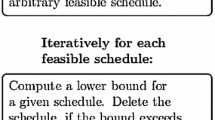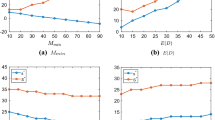Abstract
Multi-item capacity constrained inventory problems have been widely discussed in the literature. While determining an optimal solution for such problems is extremely difficult, a number of optimization and heuristic approaches based on certain assumptions have been developed. Based on the timings of the orders, these approaches can be classified into two categories - staggering and non-staggering. Most of these approaches assume stationary order quantities. There is only one heuristic known so far which allows non-stationary order quantities. In this paper, an optimal solution procedure for two items is developed. Also, an improvement over the non-stationary heuristic is proposed, and numerical examples are presented to compare the improved heuristic with the original one in terms of the ordering patterns of the items. The average annual costs computed for different approaches are also compared. Finally, it is concluded that though determining an optimal solution is very difficult, development of heuristics employing better starting solutions may be attempted for, which will give near-optimal results.
Similar content being viewed by others
References
Gallego G, Shaw D and Simchi-Levi D. “The Complexity of the Staggering Problem, and other Classical Inventory Problems”. Operations Research Letters, 12 (1992) 47–52.
Gallego G, Queyranne M and Simchi-Levi D. “Single Resource Multi-item Inventory Systems”. Operations Research, 44(4) (1996) 580–595.
Goyal SK. “A Note on Multi-Product Inventory Situations with One Restriction”. Journal of the Operational Research Society, 29 (1978) 269–271.
Güder F, Zydiak J and Chaudhry S. “Non-stationary Ordering Policies for Multi-item Inventory Systems Subject to a Single Resource Constraint”. Journal of the Operational Research Society, 46 (1995) 1145–1152.
Güder F and Zydiak J. “Ordering Policies for Multi-item Inventory Systems Subject to Multiple Resource Constraints”. Computers and Operations Research, 26 (1999) 583–597.
Hadley G and Whitin TM. “Analysis of Inventory Systems”. Prentice-Hall, Englewood Cliffs (1963).
Hartley R and Thomas LC. “The Deterministic, Two-product, Inventory System with Capacity Constraint”. Journal of the Operational Research Society, 33 (1982) 1013–1020.
Hartley R and Thomas LC. “An Algorithm for Limited Capacity Inventory Problem with Staggering”. Journal of the Operational Research Society, 34 (1983) 81–85.
Johnson LA and Montgomery DC. “Operations Research in Production Planning, Scheduling and Inventory Control”. John Wiley, New York (1974).
Page E and Paul RJ. “Multi-product Inventory Situations with One Restriction”. Operational Research Quarterly, 27(4) (1976) 815–834.
Rosenblatt MJ. “Multi-item Inventory System with Budgetary Constraint: A Comparison Between the Lagrangian and the Fixed Cycle Approach”. International Journal of Production Research, 19(4) (1981) 331–339.
Author information
Authors and Affiliations
Rights and permissions
About this article
Cite this article
Mitra, S., Chatterjee, A.K. On Capacitated Multi-item Inventory Problems. OPSEARCH 38, 319–331 (2001). https://doi.org/10.1007/BF03398639
Received:
Accepted:
Published:
Issue Date:
DOI: https://doi.org/10.1007/BF03398639




